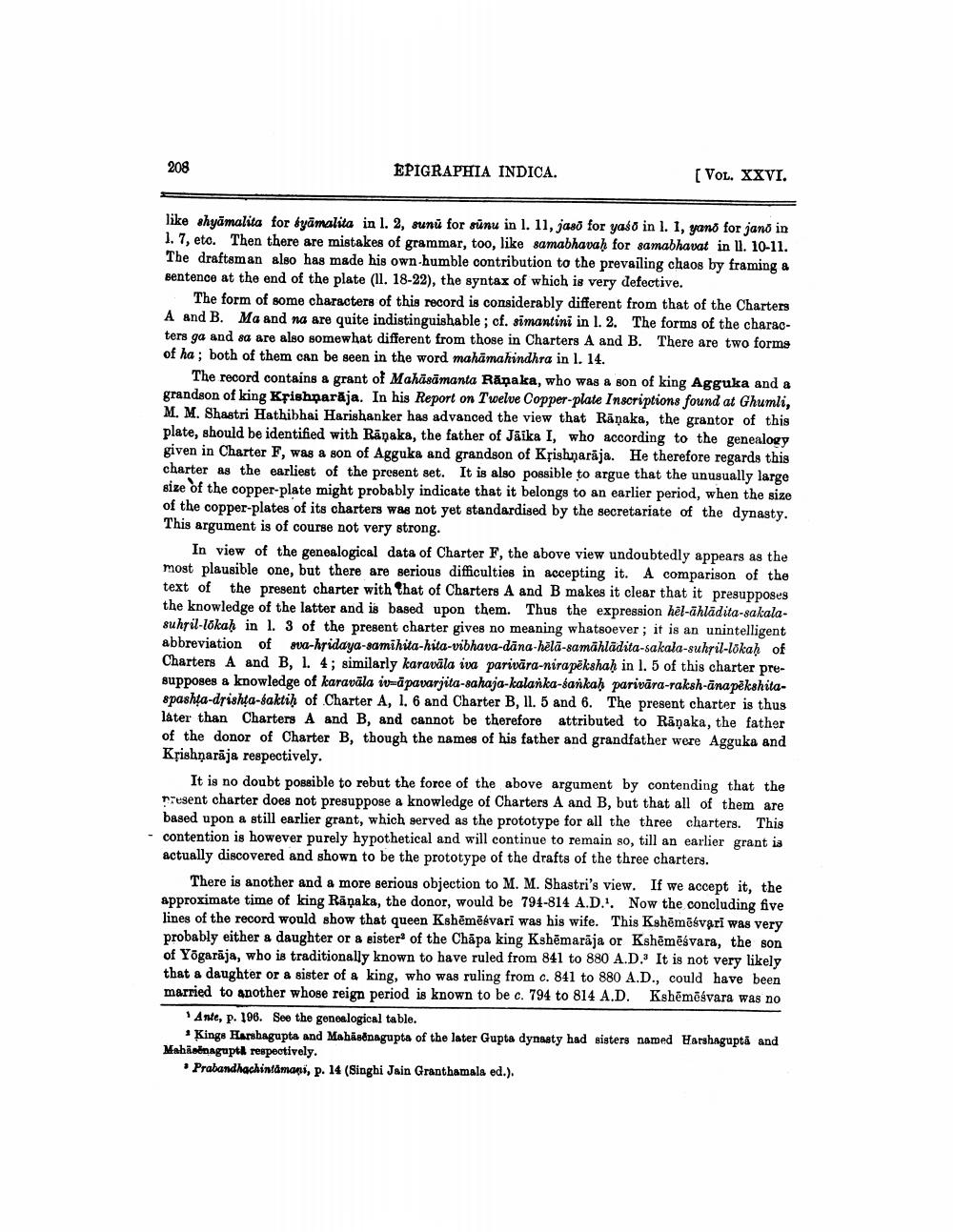________________
208
EPIGRAPHIA INDICA.
(Vol. XXVI.
like shyāmalita for byāmalita in l. 2, sunü for sūnu in l. 11, jaso for yaso in l. 1, yano for jano in 1. 7, eto. Then there are mistakes of grammar, too, like samabhavaḥ for samabhavat in II. 10-11. The draftsman also has made his own-humble contribution to the prevailing chaos by framing & sentence at the end of the plate (11. 18-22), the syntax of which is very defective.
The form of some characters of this record is considerably different from that of the Charters A and B. Ma and na are quite indistinguishable; cf. simantini in l. 2. The forms of the characters ga and sa are also somewhat different from those in Charters A and B. There are two forms of ha; both of them can be seen in the word mahāmahindhra in l. 14.
The record contains a grant of Mahāsāmanta Rāņaka, who was a son of king Agguka and a grandson of king Kfishparāja. In his Report on Twelve Copper-plate Inscriptions found at Ghumli, M. M. Shastri Hathibhai Harishanker has advanced the view that Ränaka, the grantor of this plate, should be identified with Ranaka, the father of Jāika I, who according to the genealogy given in Charter F, was a son of Agguka and grandson of Krishnarāja. He therefore regards this charter as the earliest of the present set. It is also possible to argue that the unusually large size of the copper-plate might probably indicate that it belongs to an earlier period, when the size of the copper-plates of its charters was not yet standardised by the secretariate of the dynasty. This argument is of course not very strong.
In view of the genealogical data of Charter F, the above view undoubtedly appears as the most plausible one, but there are serious difficulties in accepting it. A comparison of the text of the present charter with that of Charters A and B makes it clear that it presupposes the knowledge of the latter and is based upon them. Thus the expression hêl-ählädita-sakalasuhril-lokah in l. 3 of the present charter gives no meaning whatsoever, it is an unintelligent abbreviation of sva-hridaya-samihita-hita-vibhava-dana-hēlā-samahlādita-sakala-suhril-lokaḥ of Charters A and B, 1. 4; similarly karavāla iva parivāra-nirapēkshah in l. 5 of this charter presupposes a knowledge of karavāla iv=āpavarjita-sahaja-kalarka-sankah parivāra-raksh-anapēkshitaspashta-drishta-saktih of Charter A, 1. 6 and Charter B, 11. 5 and 6. The present charter is thus later than Charters A and B, and cannot be therefore attributed to Rāņaka, the father of the donor of Charter B, though the names of his father and grandfather were Agguka and Krishnarāja respectively.
It is no doubt possible to rebut the force of the above argument by contending that the titsent charter does not presuppose a knowledge of Charters A and B, but that all of them are
based upon a still earlier grant, which served as the prototype for all the three charters. This - contention is however purely hypothetical and will continue to remain so, till an earlier grant is actually discovered and shown to be the prototype of the drafts of the three charters.
There is another and a more serious objection to M. M. Shastri's view. If we accept it, the approximate time of king Ränaka, the donor, would be 794-814 A.D.'. Now the concluding five lines of the record would show that queen Kshēmēbvari was his wife. This Kshēmējvari was very probably either a daughter or a sister of the Chāpa king Kshēmarāja or Kshēmēśvara, the son of Yögarāja, who is traditionally known to have ruled from 841 to 880 A.D." It is not very likely that a daughter or & sister of a king, who was ruling from c. 841 to 880 A.D., could have been married to another whose reign period is known to be c. 794 to 814 A.D. Kshēmēśvara was no
1 Ante, p. 106. See the genealogical table
Kinge Harshagupta and Mahiadnagupta of the later Gupta dynasty had sisters named Harshagupta and Mahisinaguptl respectively.
• Prabandhachintamani, p. 14 (Singhi Jain Granthamala ed.).




